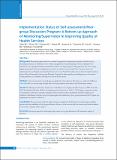Please use this identifier to cite or link to this item:
https://hdl.handle.net/20.500.14356/1801| Title: | Implementation Status of Self-assessment/Peergroup Discussion Program: A Bottom-up Approach of Monitoring/Supervision in Improving Quality of Health Services |
| Authors: | Kafle, K K Bhuju, G B Karkee, S B Prasad, R R Shrestha, N Shrestha, A D Das, P L Chataut, B D Shrestha, A Suvedi, B K |
| Citation: | Kafle k K., BhujuG. B., KarkeeS. B., PrasadR. R., ShresthaN., ShresthaA. D., DasP. L., ChatautB. D., ShresthaA., & SuvediB. K. (2014). Implementation Status of Self-assessment/Peergroup Discussion Program: A Bottom-up Approach of Monitoring/Supervision in Improving Quality of Health Services. Journal of Nepal Health Research Council. https://doi.org/10.33314/jnhrc.v0i0.493 |
| Issue Date: | 2014 |
| Publisher: | Nepal Health Research Council |
| Article Type: | Original Article |
| Keywords: | Bottom-up approach Monitoring/supervision Peer-group discussion Self-assessment Quality of services |
| Series/Report no.: | May-Aug, 2014;493 |
| Abstract: | Abstract Background: Monitoring/supervision is an essential component for improving the quality of health services including rational use of medicines. A new bottom-up approach of monitoring/supervision consisting of selfassessment/ peer-group discussion was found to be effective in improving prescribing practices. The new strategy significantly improved the prescribing practices based on standard treatment guidelines. The government has implemented it as a Program in primary health care services of Nepal. This article aims to share the implementation status of the self-assessment/peer-group discussion Program for improving the prescribing practices of common health problems and availability of drugs in the district health system. Methods: Concurrent mixed research design was applied for data collection. The data were collected at different levels of health care system using in-depth interviews, participatory observations and documentary analysis. Results: The Management Division, Department of Health Services implemented the Program in 2009-10 and the PHC Revitalization Division, DoHs is the implementation division since 2010-11. The Program comprised revision of participant’s and trainer’s manuals, training of trainers and prescribers, finalisation of health conditions and indicators, distribution of carbon copy prescription pads, and conduction of peer-group discussions.The Program was implemented in number of districts. Conclusions: The government made the policy decision to implement the Program for monitoring prescribing practices and the availability of free drugs in districts. However, it has covered only few districts and needs escalation to cover all 75 districts of the country. Keywords: bottom-up approach; monitoring/supervision; peer-group discussion; self-assessment; quality of services. |
| Description: | Original Article |
| URI: | http://103.69.126.140:8080/handle/20.500.14356/1801 |
| ISSN: | Print ISSN: 1727-5482; Online ISSN: 1999-6217 |
| Appears in Collections: | Vol. 12 No. 2 Issue 27, May - Aug 2014 |
Files in This Item:
| File | Description | Size | Format | |
|---|---|---|---|---|
| 493-Article Text-750-1-10-20141121.pdf | Fulltext Download | 86.51 kB | Adobe PDF |  View/Open |
Items in DSpace are protected by copyright, with all rights reserved, unless otherwise indicated.
